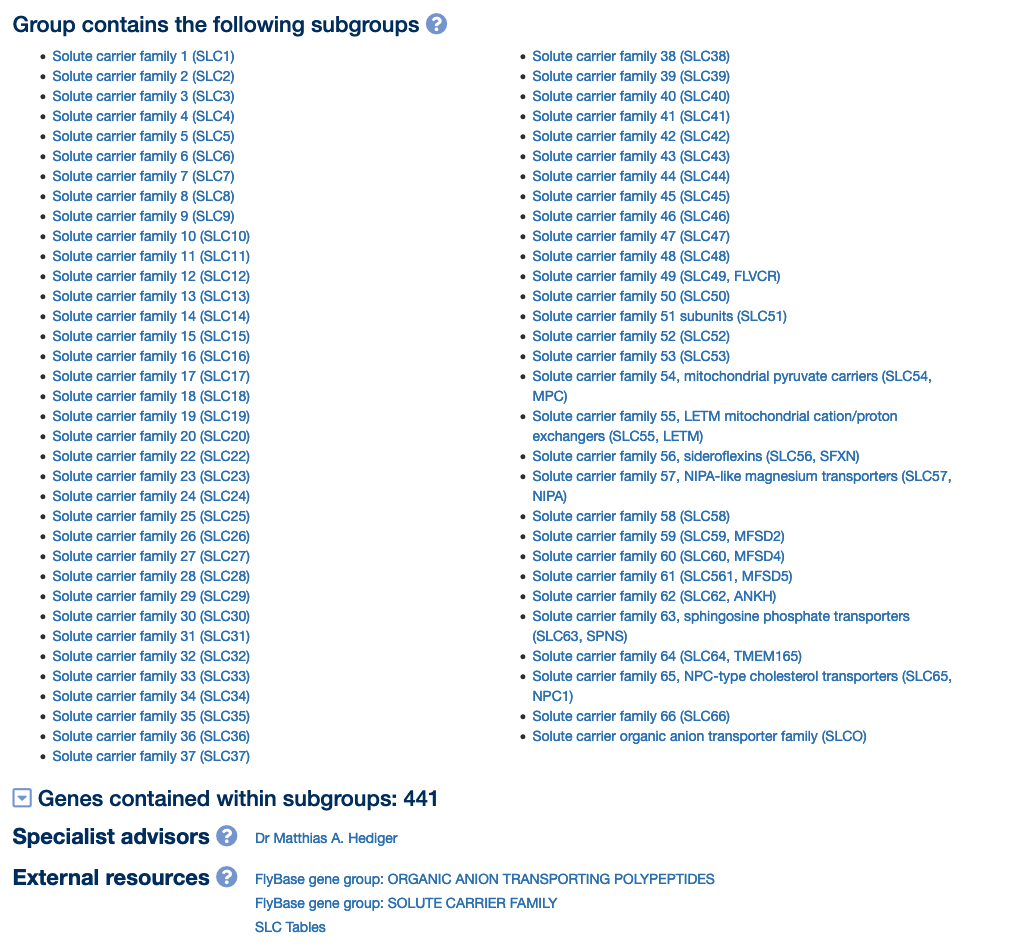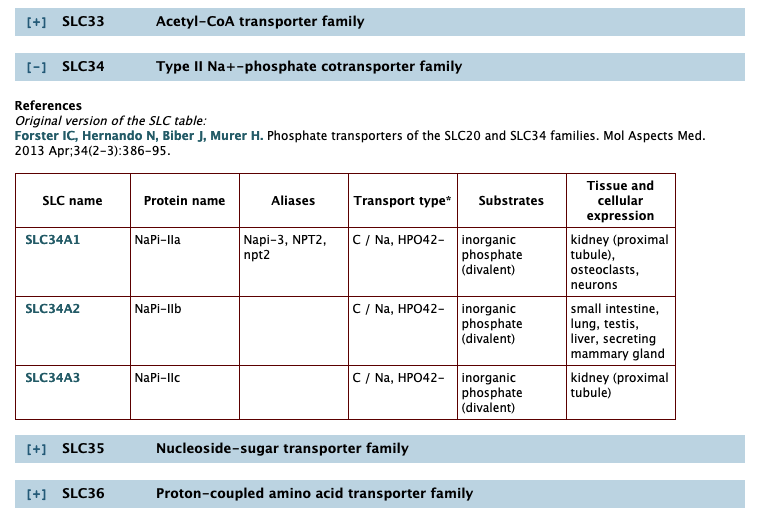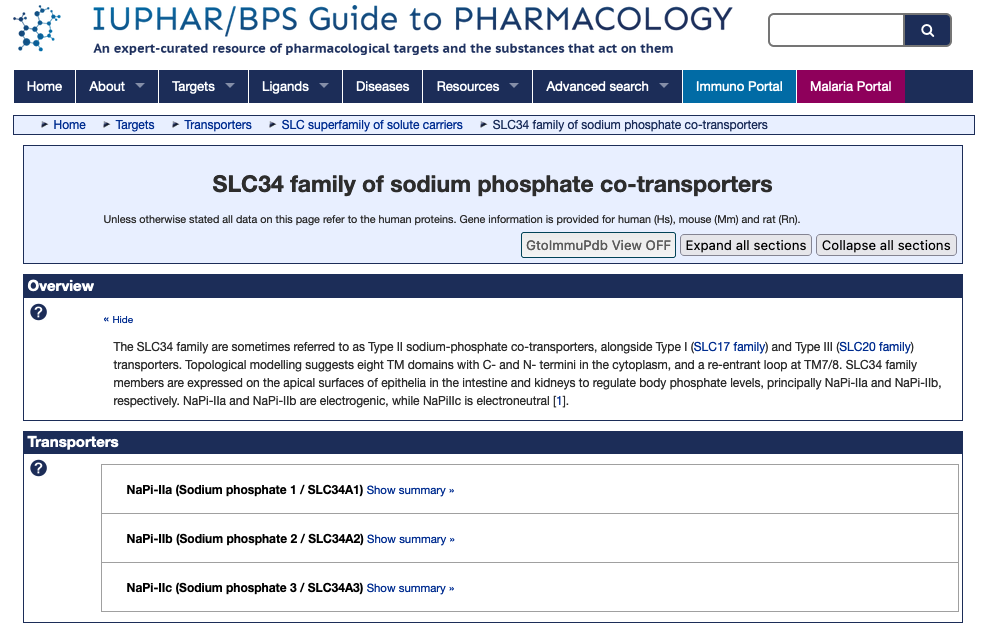Solute Carriers
HGNC, VGNC ·
Solute carriers: You asked, we listened!
The solute carrier (SLC) genes encode a diverse set of transmembrane proteins that transport a whole range of molecules including sugars, amino acids, nucleotides, inorganic ions and drugs. This is not a standard gene family but a very large group of over 400 genes each encoding as many as 24 distinct transmembrane folds with active or passive transport mechanisms. Until recently we listed all SLC genes together in a single group which provided little additional information about the members. This was raised in one of the responses to our 2022 survey which included the comment, “some groups like solute carriers state that they include 60 families - but no information or links are provided for these 60 families”. So we listened and we have now moved all genes with an approved or alias SLC symbol into one of 66 separate SLC families (fig1). This blog highlights some of the quirks of this set of families and also explains the extra information added.


Figure 1. A portion of the page for our Solute carrier families group showing all the new subgroups that have been added
The basis for the new groups
The new SLC families reflect the HGNC nomenclature that has been assigned in consultation with our specialist advisor for these genes, Professor Matthias Hediger, over the course of many years. Matthias publishes a curated table of SLCs on his BioParadigms.org site. Each SLC family shares sequence homology and has been given its own SLC number. Each member of a family has an approved symbol (or alias symbol) that starts SLC# followed by a letter to separate the family number from the family member number e.g. SLC1A2. In some families, different separating letters are used to indicate that members cluster in distinct subfamilies e.g. the large SLC35 family has members with symbols starting SLC35A-G. We have not made separate groups for each letter. We have added at least one reference as an additional source for each family.
Naming the new groups
The majority of SLC families are named simply “Solute carrier family #” in line with the names of the genes within them. It is important to remember that the families represent shared homology but that does not always mean all family members transport the same targets and some remain functionally uncharacterised. So while it is tempting to add more informative functional group names it could be misleading in some cases. However, we have added alias names taken from the SLC tables, IUPHAR/BPS Guide to Pharmacology database and publications which indicate the typical function of each family. These alternative names should also make it easier to find the family you are looking for.
Not all SLC genes are named with the SLC root - e.g. the SLC54s were all named as mitochondrial pyruvate carriers with the MPC root symbol and subsequently had SLC54 aliases added. As our focus here is to display the full collection of SLCs we have chosen to name such groups primarily as a “Solute carrier family #” but have extended the family name to reflect the approved gene names e.g. Solute carrier family 54, mitochondrial pyruvate carriers. The groups are then sorted by SLC family number.
Links to other resources
We have added links from each SLC family to the equivalent family listed in the IUPHAR/BPS Guide to Pharmacology database. Curators at this database place more emphasis on function so some of the less well characterised genes in our groups may not appear in their families e.g. they do not list SLC15A5 in their ‘SLC15 family of peptide transporters’ but do mention in their overview of the family that “SLC15A5 has unknown physiological function”. Both the IUPHAR/BPS Guide to Pharmacology database and the SLC tables (linked from “Solute carrier families”) are good places to look for more detail about the function of the gene products (fig 2.). For some families, the IUPHAR/BPS Guide to Pharmacology has broken the groups down further based on function e.g. their SLC26 family has 4 subfamilies: Selective sulphate transporters [SLC26A1-2]; Chloride/bicarbonate exchangers [SLC26A3-4, SLC26A6], Anion channels [SLC26A7, SLC26A9] and Other SLC26 anion exchangers [SLC26A5, SLC26A8, SLC26A10-11]. We have left these as a single group in line with our nomenclature.
We also have links to equivalent Drosophila SLC families in FlyBase (these will be visible following the new release of FlyBase in April). Drosophila has a total of 382 SLC genes; 11 of the 66 human families are not found in flies.


Figure 2 The SLC34 family in the BioParadigm SLC tables and IUPHAR/BPS Guide to Pharmacological - these screenshots show a selection of the information available at these sites.
Some oddities…
When is an SLC not an SLC?
Like all of biology, things sometimes get messy and the SLC families are no exception. Not every SLC gene encodes a product that can act as a transporter by itself; e.g. the SLC3 gene products are actually auxiliary subunits that form heterodimers with SLC7 gene products to transport amino acids. The SLC51 family is another ‘odd-one-out’ - reflected in its non-standard SLC nomenclature. In this case, the two family members (SLC51A and SLC51B - note no numbers after the letters) share very little homology but encode the alpha and beta subunits of a heterodimeric complex transporting steroid-derived molecules. SLC51A encodes a typical SLC multiple transmembrane structure whereas SLC51B protein product has a single transmembrane region and encodes the auxiliary subunit. This is why the SLC51 group is named differently to the others as “Solute carrier family 51 subunits”
What happened to the SLC21 family?
If you scan the list of SLC groups you’ll notice SLC21 is missing - this is because the SLC21 genes were renamed over 20 years ago to accommodate a unique, species-independent classification and naming system that has been introduced, because this family is the subject of rapid evolution, giving rise to new isoforms within a given species. The “21” and the “A” were replaced by the letter “O”, which stands for organic transporter (SLCO).
Why are there gaps in some families?
Occasionally you may notice a gap in a family - this is generally where a gene has been named in another species but is missing in humans e.g. the human SLC7 family is missing member 12 but Slc7a12 is found in rodents.
SLC pseudogenes
Some SLC families include pseudogenes - we have followed our general rule which is that we only list pseudogenes in groups when they are named as part of the numbered series. The equivalent gene in other species may well be functional e.g. human SLC23A4P is a pseudogene but mouse Slc23a4 is protein coding. In many cases, these pseudogenes may have originally been named as protein coding genes and subsequently been shown to be pseudogenes - some may have been published so it is preferable to include these in the group rather than leave a gap in the family.
New developments in the world of SLCs
Recent publications suggest more human genes could be classified as SLCs. Ferrada and Superti-Furga combined evolutionary information with proteome-wide structure models recently made available through the AlphaFold resource to produce their integrative classification of solute carriers. Their analysis expanded the number of described transmembrane folds for SLC proteins from 14 to 24 and related orphan genes to functionally characterized families.
Gyimesi and Hediger used computational sequence similarity searches to find ~120 additional proteins in human with potential SLC-like properties. Some of the proteins clustered with existing SLC families but a total of 36 new groupings were identified. More work is required to decide if these should be added to the ‘Solute carriers families’ group- we will continue to work closely with experts before assigning SLC nomenclature to the additional genes. Watch this space!
